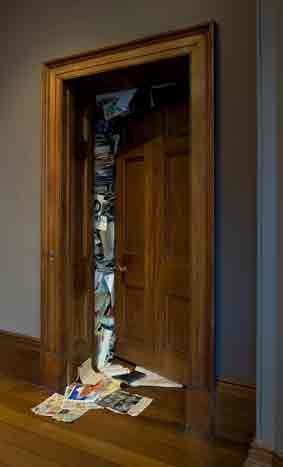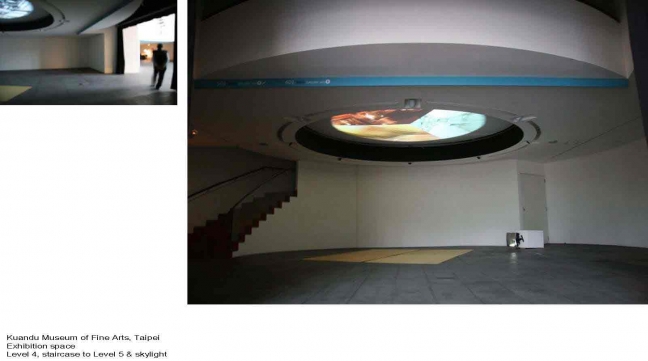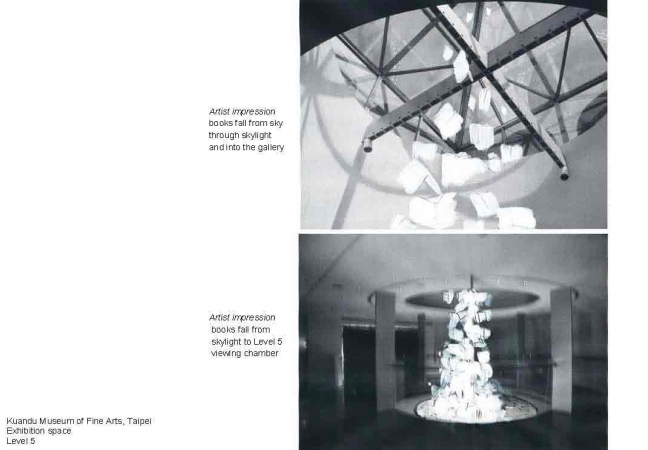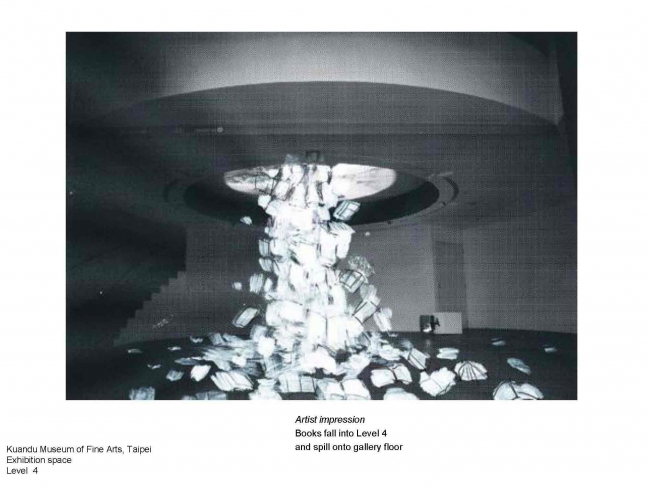書籍計畫 - Jayne Dyer個展
2009.10.03~2009.12.31
09:00 - 17:00
「書本計畫」 維托 .阿康奇…….將頁面定義為行動的區域。在他的【詩學筆記】中,他將文字定義為行動的道具, 而頁面就如同一個物件、一個容器、一張地圖以及一個運動的場域。 ----- 安.羅梨瑪.頁面選定:重寫觀念藝術.1999 當文字與視覺合併時會發生什麼呢? 在「聲刺」與日益增加的無紙化訊息交流的年代裡,珍.戴爾使用語言和書本與文庫較不拘謹的論點去討論視覺藝術 與語言學的關係。她對我們將書本當作累積事實、假設說與虛構之寶庫的關係提出疑問。 在她近來的作品中,書本自門廊溢出,書柱模擬建築,甚或懸浮在空間中;文字作品建構自私密對話而透過個人的故 事,城市便於此浮出形貌。 The Book Project Vito Acconci … defined the page as an area in which to act. In his ‘notes on poetry’ he defines words as props for movement and the page as a thing, a container, a map and a field for movement. --------Anne Rorimer, Siting the Page: rewriting conceptual art 1999 What happens when language and the visual arts conflate? In an age of the sound-bite and increasingly paperless information exchange, Jayne Dyer uses language and books and the loose proposition of the library to discuss the relationship of visual arts with linguistics. She raises questions about our relationship with books as repositories of accumulated facts, hypotheses or fictions. In recent work books spill from doorways, columns of books mimic architecture or suspend in space, text works are constructed from private conversations and cities are mapped through individual stories.
「書本計畫」 維托 .阿康奇…….將頁面定義為行動的區域。在他的【詩學筆記】中,他將文字定義為行動的道具, 而頁面就如同一個物件、一個容器、一張地圖以及一個運動的場域。 ----- 安.羅梨瑪.頁面選定:重寫觀念藝術.1999 當文字與視覺合併時會發生什麼呢? 在「聲刺」與日益增加的無紙化訊息交流的年代裡,珍.戴爾使用語言和書本與文庫較不拘謹的論點去討論視覺藝術 與語言學的關係。她對我們將書本當作累積事實、假設說與虛構之寶庫的關係提出疑問。 在她近來的作品中,書本自門廊溢出,書柱模擬建築,甚或懸浮在空間中;文字作品建構自私密對話而透過個人的故 事,城市便於此浮出形貌。 The Book Project Vito Acconci … defined the page as an area in which to act. In his ‘notes on poetry’ he defines words as props for movement and the page as a thing, a container, a map and a field for movement. --------Anne Rorimer, Siting the Page: rewriting conceptual art 1999 What happens when language and the visual arts conflate? In an age of the sound-bite and increasingly paperless information exchange, Jayne Dyer uses language and books and the loose proposition of the library to discuss the relationship of visual arts with linguistics. She raises questions about our relationship with books as repositories of accumulated facts, hypotheses or fictions. In recent work books spill from doorways, columns of books mimic architecture or suspend in space, text works are constructed from private conversations and cities are mapped through individual stories.
珍.戴爾
地點: 週二至週日上午10:00-下午5:00 當文字與視覺合併時會發生什麼呢?
在「聲刺」與日益增加的無紙化訊息交流的年代裡,珍.戴爾使用語言和書本與文庫較不拘謹的論點去討論視覺藝術與語言學的關係。她對我們將書本當作累積事實、假設說與虛構之寶庫的關係提出疑問。在她近來的作品中,書本自門廊溢出,書柱模擬建築,甚或懸浮在空間中;文字作品建構自私密對話而透過個人的故事,城市便於此浮出形貌。
澳洲籍藝術家珍.戴爾經營多面向的創作。她的國際經驗包括自1994年開始以來於亞洲的展覽與委託製作。2009年於西藏將發表澳洲文協的新作獎助研究;駐村經歷為2008年於臺北國際藝術村(Asialink交流計畫)、2007年於香港嶺南大學、1996年於北京、1999年及2005年於巴黎、1992年於義大利蒙納許大學。她的作品不定期於各大國際藝術期刊中被評論,作品並於澳洲、中國、日本、英格蘭供公共及私人收藏,在2005年,她因藝術教育貢獻榮獲澳洲公眾服務公益大獎。戴爾應邀於關渡美術館駐館創作並於2009年關渡藝術節發表大型裝置。戴爾為澳洲墨爾本Anna pappas藝廊(www.annapappas.com)及雪梨King Street藝廊(www.kingstreetgallery.com.au)代理藝術家。
在「聲刺」與日益增加的無紙化訊息交流的年代裡,珍.戴爾使用語言和書本與文庫較不拘謹的論點去討論視覺藝術與語言學的關係。她對我們將書本當作累積事實、假設說與虛構之寶庫的關係提出疑問。在她近來的作品中,書本自門廊溢出,書柱模擬建築,甚或懸浮在空間中;文字作品建構自私密對話而透過個人的故事,城市便於此浮出形貌。
澳洲籍藝術家珍.戴爾經營多面向的創作。她的國際經驗包括自1994年開始以來於亞洲的展覽與委託製作。2009年於西藏將發表澳洲文協的新作獎助研究;駐村經歷為2008年於臺北國際藝術村(Asialink交流計畫)、2007年於香港嶺南大學、1996年於北京、1999年及2005年於巴黎、1992年於義大利蒙納許大學。她的作品不定期於各大國際藝術期刊中被評論,作品並於澳洲、中國、日本、英格蘭供公共及私人收藏,在2005年,她因藝術教育貢獻榮獲澳洲公眾服務公益大獎。戴爾應邀於關渡美術館駐館創作並於2009年關渡藝術節發表大型裝置。戴爾為澳洲墨爾本Anna pappas藝廊(www.annapappas.com)及雪梨King Street藝廊(www.kingstreetgallery.com.au)代理藝術家。
珍.戴爾
地點: 週二至週日上午10:00-下午5:00 當文字與視覺合併時會發生什麼呢?
在「聲刺」與日益增加的無紙化訊息交流的年代裡,珍.戴爾使用語言和書本與文庫較不拘謹的論點去討論視覺藝術與語言學的關係。她對我們將書本當作累積事實、假設說與虛構之寶庫的關係提出疑問。在她近來的作品中,書本自門廊溢出,書柱模擬建築,甚或懸浮在空間中;文字作品建構自私密對話而透過個人的故事,城市便於此浮出形貌。
澳洲籍藝術家珍.戴爾經營多面向的創作。她的國際經驗包括自1994年開始以來於亞洲的展覽與委託製作。2009年於西藏將發表澳洲文協的新作獎助研究;駐村經歷為2008年於臺北國際藝術村(Asialink交流計畫)、2007年於香港嶺南大學、1996年於北京、1999年及2005年於巴黎、1992年於義大利蒙納許大學。她的作品不定期於各大國際藝術期刊中被評論,作品並於澳洲、中國、日本、英格蘭供公共及私人收藏,在2005年,她因藝術教育貢獻榮獲澳洲公眾服務公益大獎。戴爾應邀於關渡美術館駐館創作並於2009年關渡藝術節發表大型裝置。戴爾為澳洲墨爾本Anna pappas藝廊(www.annapappas.com)及雪梨King Street藝廊(www.kingstreetgallery.com.au)代理藝術家。
在「聲刺」與日益增加的無紙化訊息交流的年代裡,珍.戴爾使用語言和書本與文庫較不拘謹的論點去討論視覺藝術與語言學的關係。她對我們將書本當作累積事實、假設說與虛構之寶庫的關係提出疑問。在她近來的作品中,書本自門廊溢出,書柱模擬建築,甚或懸浮在空間中;文字作品建構自私密對話而透過個人的故事,城市便於此浮出形貌。
澳洲籍藝術家珍.戴爾經營多面向的創作。她的國際經驗包括自1994年開始以來於亞洲的展覽與委託製作。2009年於西藏將發表澳洲文協的新作獎助研究;駐村經歷為2008年於臺北國際藝術村(Asialink交流計畫)、2007年於香港嶺南大學、1996年於北京、1999年及2005年於巴黎、1992年於義大利蒙納許大學。她的作品不定期於各大國際藝術期刊中被評論,作品並於澳洲、中國、日本、英格蘭供公共及私人收藏,在2005年,她因藝術教育貢獻榮獲澳洲公眾服務公益大獎。戴爾應邀於關渡美術館駐館創作並於2009年關渡藝術節發表大型裝置。戴爾為澳洲墨爾本Anna pappas藝廊(www.annapappas.com)及雪梨King Street藝廊(www.kingstreetgallery.com.au)代理藝術家。








